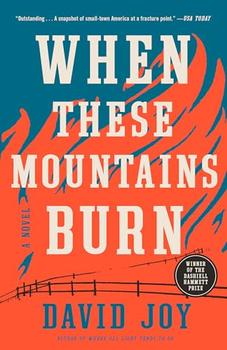Summary | Excerpt | Reviews | Beyond the Book | Read-Alikes | Genres & Themes | Author Bio

This article relates to When These Mountains Burn
 David Joy's novel When These Mountains Burn is set in and around the town of Cherokee, North Carolina, which is situated in the far western corner of the state, abutting Great Smoky Mountains National Park. Cherokee is the capital and cultural center of the Eastern Band of Cherokee Indians (EBCI) and is located in an area known as The Qualla Boundary, or simply The Qualla. This 100-square-mile parcel of land isn't a reservation; it was purchased by the EBCI from the United States federal government and is considered a sovereign nation.
David Joy's novel When These Mountains Burn is set in and around the town of Cherokee, North Carolina, which is situated in the far western corner of the state, abutting Great Smoky Mountains National Park. Cherokee is the capital and cultural center of the Eastern Band of Cherokee Indians (EBCI) and is located in an area known as The Qualla Boundary, or simply The Qualla. This 100-square-mile parcel of land isn't a reservation; it was purchased by the EBCI from the United States federal government and is considered a sovereign nation.
The mountains known today as the Southern Appalachians were home to the Cherokee people for centuries before the arrival of Europeans. The Cherokees made some attempts to adapt to the culture and rules of the European settlers, wearing Western-style clothes, establishing a governing structure with a constitution, creating a written language and publishing a Cherokee-language newspaper starting in 1828. Despite these efforts at assimilation, they were subject to the whims of the US government, which used the Indian Removal Act to relocate the population in 1838. Around 16,000 Cherokees were among the more than 60,000 Natives who were forced from their home territories and marched to Oklahoma on a journey of over 5,000 miles that became known as the Trail of Tears; between 25% and 50% died along the way.
While the vast majority were expelled, not all the Cherokees left. Some hid in the hills to avoid capture, while others were able to stay based on earlier treaties. An estimated group of about 800 people occupied land near the remote Oconaluftee River, and the EBCI is comprised primarily of their descendants. William Holland Thomas (1805-1893), a white man adopted into the EBCI, studied law and negotiated with the United States government on behalf of his adopted people. In the 1840s and 1850s, he personally bought land that would become a large part of The Qualla Boundary. The US government recognized the right of the Cherokees to live in North Carolina in 1866, and formally established the borders of The Qualla in 1876. The EBCI was officially recognized by the federal government in the 20th century, and is one of three Cherokee tribes with that designation — the other two being the Cherokee Nation and the United Keetoowah Band of Cherokee Indians, both based in Oklahoma.
Today, the EBCI has more than 14,000 members. Those seeking tribal membership must be over 18, prove they have an ancestor on the Baker Roll of 1924 (a census conducted by the Congressionally appointed Eastern Cherokee Enrolling Commission) and be at least 1/16th Cherokee by blood. As a sovereign nation, the EBCI is autonomous, with its own democratically elected government, its own laws and law-enforcement agency (tribal police), and its own public school system.
Being on the southern boundary of Great Smoky Mountains National Park, the town of Cherokee has long been a tourist destination with many campgrounds and attractions. In 1997, the tribe opened a massive casino and hotel in partnership with Caesars Entertainment – Harrah's Cherokee – which provided a boost to the local economy. They decided that half the profits from the venture would go directly to tribe members; each person received over $7000 in 2018. The city also boasts an amazing museum: The Museum of the Cherokee Indian, a state-of-the-art facility funded by casino profits and designed by an engineering team from the Walt Disney Company.
Bridge over the Oconaluftee River in Cherokee, North Carolina, by Billy Hathorn (CC BY 3.0)
Filed under Places, Cultures & Identities
![]() This article relates to When These Mountains Burn.
It first ran in the August 19, 2020
issue of BookBrowse Recommends.
This article relates to When These Mountains Burn.
It first ran in the August 19, 2020
issue of BookBrowse Recommends.
Your guide toexceptional books
BookBrowse seeks out and recommends the best in contemporary fiction and nonfiction—books that not only engage and entertain but also deepen our understanding of ourselves and the world around us.